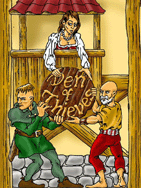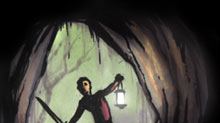by Demian Katz
 Den of Thieves
Den of Thieves
Rival Den of Thieves
Published by Rogue Publishing
Designed by Scott David Gray
Illustrated by Patrick Crusiau
26 cards plus rules and turn order card per deck (players must provide paper, pencil and counters)
$7.95 each
Rogue Publishing is an interesting company. After starting as a
publisher of eBook editions of classic adventure drama and fiction, they
branched out into gaming with the interesting one-off LARP Priceless.
This was followed with several interesting FUDGE-based role-playing
games. Now, with Den of Thieves and Rival Den of Thieves, the company
has ventured into totally unfamiliar territory; not only are these games
attractive, printed products rather than electronic downloads, but
they're also card games rather than RPGs. Rogue Publishing's new
release announcements are usually surprising, and once again, the
surprise is a pleasant one.
 One of the things I love about card games is that they offer the opportunity for creating a complex game without a whole lot of rules to explain before starting -- you can always put the complicated bits on the
cards themselves, which is called an exception-based rule system. Both
Den of Thieves games are built on this premise. The basic rules
explain little beyond the order of play; the excitement comes from the
interaction of the cards, each of which contains a paragraph of rules
and represents a different kind of thief. The difference between the
two games is that Den of Thieves features mostly small-time
thieves like the Urchin and the Woman of Easy Virtue, while Rival Den
of Thieves has more intellectual fiends such as the Lawyer and the
Gentleman Burglar. The cards in Rival are generally a bit more
complex, making the latter game a better introduction to the system.
However, it's worth eventually buying both games -- the two decks can be
combined, doubling the maximum number of supported players from five to
ten.
One of the things I love about card games is that they offer the opportunity for creating a complex game without a whole lot of rules to explain before starting -- you can always put the complicated bits on the
cards themselves, which is called an exception-based rule system. Both
Den of Thieves games are built on this premise. The basic rules
explain little beyond the order of play; the excitement comes from the
interaction of the cards, each of which contains a paragraph of rules
and represents a different kind of thief. The difference between the
two games is that Den of Thieves features mostly small-time
thieves like the Urchin and the Woman of Easy Virtue, while Rival Den
of Thieves has more intellectual fiends such as the Lawyer and the
Gentleman Burglar. The cards in Rival are generally a bit more
complex, making the latter game a better introduction to the system.
However, it's worth eventually buying both games -- the two decks can be
combined, doubling the maximum number of supported players from five to
ten.
Regardless of which deck or decks you use, the essentials are the same.
At the start of the game, each player is given three coins and a hand of
three cards. Additionally, a bank is set up containing six coins plus
three additional coins per player, and the top card of the draw pile is
turned face-up to start a discard pile. All of the players hands are also
turned face-up so that everybody always knows what everybody else has.
Each turn consists of five phases, repeated until somebody wins the game
by collecting ten or more coins. First, players each draw a card from
either the top of the discard pile or the top of the deck. Like the
initially dealt cards, this is immediately shown to everyone else; at no
point does anyone hold a card that no one else knows about. An element of
secrecy does come into play during the second phase, however. At this
point, players pick up all of their cards and decide which one to use on
the current turn. This is designated the active card and set aside by
itself face-down, while the remaining cards are set face-down in a pile
known as the den. Once everyone has decided on a card to use, active
cards are revealed one by one and their actions are resolved.
Some cards allow one player to rob another or the bank. The Bunko Artist,
one of the simpler cards, simply allows three coins to be grabbed from the
bank; the Cutpurse, on the other hand, requires a whole little guessing
game to be played in order to figure out who has been robbed. Other cards
target thieves in other players' dens (like the Assassin, who can kill a
card for a small fee) or cooperate with cards in the den (the Shadow, for
example, allows a player to wait until everyone else has made a move and
then pick a different active card). There are also some defensive cards
which can act from within the den; the Fall Guy, for example, can protect
an active card from being killed or captured.
After all actions for the current turn have been resolved and assuming
that no one has won, players who failed to steal enough money to keep
their personal stashes over three coins are forced to do honest work, thus
earning a single coin from the bank. Players then discard back down to
three cards, reveal their current holdings, and prepare to begin the
process anew. Once the first turn has passed, there are generally
interesting cards peeking temptingly from the discard pile and numerous
scores to settle, and things just get more interesting as time goes by.
The wide variety of cards and the balance between open knowledge of other
players cards and the secrecy of which will be used in the current turn
makes for an appropriate-feeling game of roguery, filled with
back-stabbing, bluffing and surprises.
Conclusions
Den of Thieves doesn't feature any gameplay mechanisms so overwhelmingly
original that they're worth talking about, and it lacks the wacky sense
of humor that makes so many inexpensive card games entertaining in spite
of unoriginality. Still, both decks stand above average in terms of
quality with their nice color boxes and decent-quality, glossy (though
strangely sticky) cards, and they offer a fun and fast-playing (if
modest) game that potentially supports a large number of people. I
don't expect this to win any awards, but that doesn't mean it's not a
worthy addition to your collection. If you enjoy a quick game of cards
with a healthy dose of backstabbing, you'll probably have fun with this;
the fact that the game is potentially quite expandable is a nice bonus.
Perhaps some more dens will open up one of these days.




